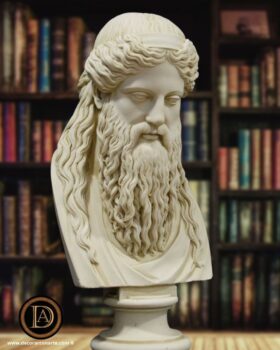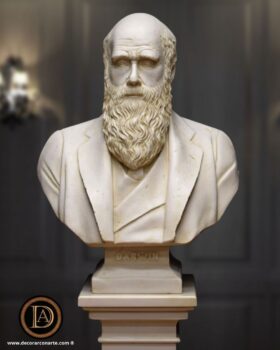Description
Bust of Caesar Augustus, a reproduction crafted in molded marble (marble powder bonded with resins). Finished with the application of aging patinas based on natural earth. The material used and the patina finish give it the appearance of an original ancient sculpture beautified by the passage of time.
Dimensions: Height: 62 cm. Width: 46 cm. Depth: 26 cm.
Approximate weight: 14 kilograms.
A reproduction of a sculpture, ideal for interior decoration (living rooms, lobbies, offices, and libraries) and for outdoor use, gardens, and terraces, resistant to exposure to the weather.
Octavian Augustus, born as Gaius Octavius (63 BC-14 AD), was the first emperor of Rome, and his rule marked the end of the Republic. Octavian had been adopted by his great-uncle Julius Caesar, and after Caesar’s assassination, he became his successor. He ruled as a triumvirate alongside Lepidus and Mark Antony until his confrontation with the latter in the Civil Wars. In the Battle of Actium (31 BC), Octavian ultimately defeated the combined forces of Mark Antony and Cleopatra and emerged as the undisputed leader of Rome. In 27 BC, he became the first emperor with the name Caesar Augustus, ushering in an Empire that would last for four centuries. His rule is marked by a period of stability and prosperity known as the Pax Romana, lasting about two hundred years. Augustus also implemented significant political and administrative reforms, leaving a lasting legacy by consolidating the structures of the Empire. After his death, he was deified, and official cults were dedicated to him in temples throughout the empire. Subsequently, all emperors who followed adopted the title of Caesar Augustus in his honor.
This historical figure has inspired numerous works of art from Classical Antiquity to the present day. A figure like this bust of Caesar Augustus helps create a unique atmosphere in our favorite corner or workplace, such as the living room, entrance, library, or office. Placed in our garden, the figure of the emperor emerges among the surrounding vegetation, establishing a dialogue between nature and art.
Reproductions of large classical sculptures inspired by figures from Antiquity, like this sculpture of Caesar Augustus, add an elegant and timeless touch to the decoration of our home.




























Cristina –
I can’t stop admiring it! The texture and detail are so lifelike.